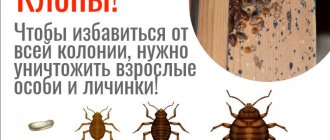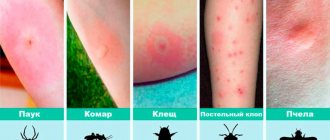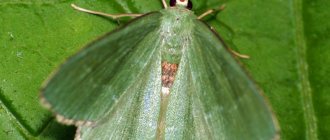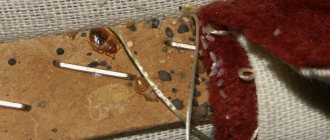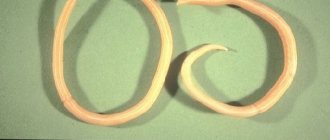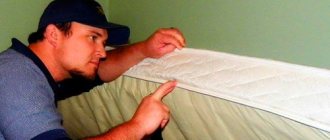The common ground bug is a bug belonging to the suborder Pentatomomorpha. These are small insects that feed on plant sap. Today, more than four thousand species with a wide habitat are known. Insects survive the cold season in adult stages (with rare exceptions in the larval stage). Often lead to the death of plants. In the European part there are about four hundred species and subspecies of terrestrials. Insects have a characteristic specific odor. The reason for this is the presence of glands that secrete cymitic acid.
In nature, there are many species of animals and insects that cause serious damage to agricultural and garden plants. According to official statistics, about twenty percent of crops around the world are destroyed annually from their vital activity. Garden bugs are widespread throughout the globe. They have sucking type mouthparts and are adapted to feeding primarily on liquid food (carnivorous species are less common). Insects damage the stems and foliage of plants, on which characteristic brown spots appear. Methods for killing insects depend on their type and the structure of their mouthparts. These may be internal chemicals that enter the digestive tract along with plant sap. In the fight against bedbugs, external insecticides are most often used. They penetrate the insect’s body through the chitinous membrane and respiratory organs.
Garden bugs
Bedbugs are insects with a characteristic odor, whose vital activity harms garden crops and also reduces the quality of life of mammals and humans. Red bugs (garden bugs) feed on plant sap, which can lead to the death of immature shoots. This order of hemiptera has glands that produce cimycin acid, which repels birds. Insects reproduce quickly and easily adapt to extreme environmental conditions.
The common ground bug is a family of bugs distinguished by its characteristic color (black-red or black-yellow) and body shape. The size varies from one to 12 millimeters. Distributed throughout the world. Adults and larvae of the bug feed mainly on cruciferous vegetables (cabbage, radish, and others). In this case, insects damage the skin of the plant, and yellowish spots remain on the leaves. Bedbug eggs are protected by a chitinous shell and are bright red in color. The mounted groundling feeds with the help of a piercing-sucking proboscis located in the lower part of the head. There are also several similar species in nature. For example, bugs of the family Lygaeida, unlike the land bug, are capable of flight. The wings have membranes. The sides and chest are black.
As a rule, with the onset of warm weather (late April early May), the common ground terrestrial begins to gather in large colonies and actively reproduce. Clusters of insects can be seen on garden plants, as well as on smoldering stumps and fences. This is explained by the fact that insects survive the winter season in the adult stage, hiding under fallen leaves and tree bark.
During the breeding season, females lay eggs on the lower surface of the leaves. The cycle of transformation into an adult is about thirty days. In this case, the larvae experience five molts, constantly changing color. Of the four hundred eggs laid, less than half turn into adult insects. This is due to the fact that not all larvae are able to emerge from the hard chitinous shell, which performs a protective function. The larvae of the ground beetle are capable of destroying young, immature shoots, so in case of large numbers it is necessary to chemically treat the crops.
There are several main signs by which affected plants are identified. For example, flower petals fall off almost immediately after they appear. Some of them don't even have time to bloom. If the leaves of ripe cruciferous fruits begin to curl, this also indicates the vital activity of the terrestrial plant. The destruction of the population, as a rule, is carried out in early spring, before the insects have entered the stage of active reproduction. If infection cannot be avoided, plants are treated with special preparations (such as Bankol). It should be noted that red bug bites are safe for human health and do not cause pain.
Methods of fighting bedbugs with soldiers
Despite the fact that scientists still do not classify the soldier bug as a parasite, it is dangerous for garden crops. Before you start fighting the parasite, you need to make sure that you are dealing with the soldier bug. Among all summer cottage plants, these parasites give preference to:
- beets;
- cabbage;
- grapes;
- flowers;
- umbrella plants.
If you find that these plants have begun to weaken, most likely the cause is soldier bugs. Insect bites leave marks on plants in the form of yellow spots.
It is quite difficult to remove soldier bugs from a summer cottage. This is due to the fact that females lay eggs inside the leaves and stems of the plants on which they feed. Methods for controlling bedbugs are divided into 3 groups: mechanical, biological and chemical.
Mechanical methods of control
This group of methods involves collecting bugs and their subsequent destruction. This is an ineffective way to kill parasites and will take a lot of time. Summer residents resort to this method if it is not possible to use insecticides (on the eve of harvest, for example). If bedbugs have already taken root in a summer cottage, then the mechanical method of combating the parasite is ineffective.
Biological control methods
These control methods involve planting plants that repel bedbugs. One such plant is black cohosh. It blooms beautifully, and in addition to helping to get rid of harmful insects, it will decorate your summer cottage.
Each summer resident has his own recipe for fighting the beetle. Some people manage to get rid of the harmful beetle using a decoction of onion peels. This product does not damage the soil. All plants growing in the garden must be treated with the decoction. The red beetle is also afraid of wood ash, which we first dilute in water. Some summer residents use soap or mustard solution to fight soldiers.
Chemical control methods
Chemical methods of controlling bugs with soldier bugs involve the use of insecticides. There are a large number of different pesticides on the market, which are not cheap today
Therefore, it is important to choose an effective insecticide that will help get rid of bedbugs. “Bankol” is popular in the market today. This insecticide does not have a pronounced odor
It can be used to combat not only bedbugs, but also other parasites commonly found in the garden. When ingested by an insect, the drug blocks the functioning of the central nervous system, which causes paralysis, which causes the death of the insect. The peculiarity of the insecticide is that it does not kill insects that are harmless to the garden plot, and is not dangerous to humans. Before using the drug, read its description. If the manufacturer's recommendations regarding the dosage of the pesticide are not followed, the product will be ineffective
This insecticide does not have a pronounced odor. It can be used to combat not only bedbugs, but also other parasites commonly found in the garden. When ingested by an insect, the drug blocks the functioning of the central nervous system, which causes paralysis, which causes the death of the insect. The peculiarity of the insecticide is that it does not kill insects that are harmless to the garden plot, and is not dangerous to humans. Before using the drug, read its description. If the manufacturer's recommendations regarding the dosage of the pesticide are not followed, the product will be ineffective.
When choosing control methods, you need to answer the question: “which recipe is the most acceptable for me?” If you do not want to harm the soil and crops, then it is advisable to adopt traditional methods of control. If you need to get rid of bedbugs in a short time, it is better to use an insecticide.
What does a wood bug look like?
The green tree bug has a sharp and long proboscis, with the help of which it obtains food for itself. Its body has a characteristic structure - a wide and thick shell, like a shield. Because of it, the insect is sometimes called a stink bug. The color of the shell is bright green or dirty brown with red splashes. The development period of the green bug lasts more than a week. A durable shield-shell made of chitin helps the insect fight external influences. The molting period - when the stink bug sheds its old shell - is a dangerous time. If the bug does not have time to get out of its tight shell, it dies. In the photo, these insects look harmless, but their disgusting characteristic smell when met in person leaves a less favorable impression.
Is the wood bug harmful?
- The insect can eat crops;
- The pronounced unpleasant smell of a bug can ruin the taste of berries or any other fruit after interacting with it;
- It poses no threat to human habitation, other than being aesthetically unsightly.
Sometimes there are invasions of these insects on garden plots, as a result of which a significant part of the crops or plantings perishes, and the wood also deteriorates.
Family Shieldworts, Hemispherical Shieldworts and Tortoiseshell Shieldworts
Ground shield bugs (Cydnidae) are found everywhere and number about 750 species. Some species are pests of cereals and peanuts. They live on the soil surface, in litter, and feed on plant roots, although some species feed on mint grains.
Hemispherical shield insects (Plataspidae) - about 530 species. Bedbugs with a body length of 2-20 mm are distinguished by a rounded shield that reaches the top of the abdomen.
Shield bugs (Scutelleridae) are a small family of bugs, numbering about 100 species, body length 6-10 mm, and have a well-developed shield covering the body. Turtle bugs are often agricultural pests that live in fields and feed on plant sap.
The tortoiseshell bug (Eurygaster integriceps) is a species of bugs in the family Stink bugs that are serious pests in agriculture. Body length 10-13 mm. These bugs overwinter in the forest, in fallen leaves, where they fly from the fields and can travel considerable distances. Insects feed on seedlings of all grain crops and wild cereals. Our organization provides ]disinfestation of bugs[/anchor] and other agricultural pests.
Harmful turtle
Adomerus biguttatus
Canthophorus mixtus
Tritomegas bicolor
Coptosoma scutellatum
Eurygaster austriaca
Eurygaster maura
Irochrotus caspius
Odontoscelis fuliginosa
Odontotarsus robustus
Pachycoris klugii (photo by Evgeniy Fedorov)
Phimodera humeralis
How to identify a wood bug
It differs from other insects in two ways:
- pentagonal body shape;
- inability to fly, despite having wings.
Tree bugs are named so due to their main habitat - on trees and bushes. In winter, stink bugs are usually not found, as they are in a state of hibernation. They rarely get into apartments; they are usually brought from the garden or market along with fruits and flowers.
The stink bug differs from other insects by its specific smell, which is difficult to confuse.
Clubweed family (Rhopalidae)
These are mostly inconspicuous bugs of medium size (usually about 10 mm) with an elongated body. They feed only on plants, mainly herbs. There are only about 200 species in the world fauna.
Read: Soft-bodied beetles (Cantharidae)
One of the few representatives of the family that attracts attention with its bright red and black color. The henbane bug is found on various grasses, including vegetables and potatoes, but does not harm these crops.
Reasons for the appearance of wood bugs in the house
Living quarters are not the most comfortable habitat for shield bugs. They usually end up in an apartment by accident in single copies. A massive invasion is possible if there are plants on which they live under the window of the house. In the event of a sudden change in weather (cold temperatures, extreme heat or wind), they may seek more comfortable conditions and move to an apartment.
In a village house, invasions occur more often, but for a city apartment such phenomena are atypical.
Can shield bugs breed in an apartment?
An apartment or other type of human habitation does not attract stink bugs as a breeding site and permanent habitat. There is no power source for them here.
Despite their name, they do not feed on wood, chew furniture, or threaten wood products.
The usual breeding site is the underside of the leaf on which eggs are laid.
Family Coreidae
Medium-sized and large (5.3-16 mm), dimly colored bugs with very durable integuments. About 1,600 species are known in the world fauna.
The large (up to 15 mm) brown bug attracts attention in the spring, when overwintered bugs fly buzzing from plant to plant to feed and bask in the sun. Fed females prefer to lay eggs on the leaves of sorrel and other buckwheat. The angular larvae of the bug look like the fruits of these plants; they often feed on the fruits.
How to get rid of a wood bug
It is not difficult to get rid of stink bugs in an apartment if they are present in single copies. You can simply collect them and throw them out the window or flush them down the toilet.
